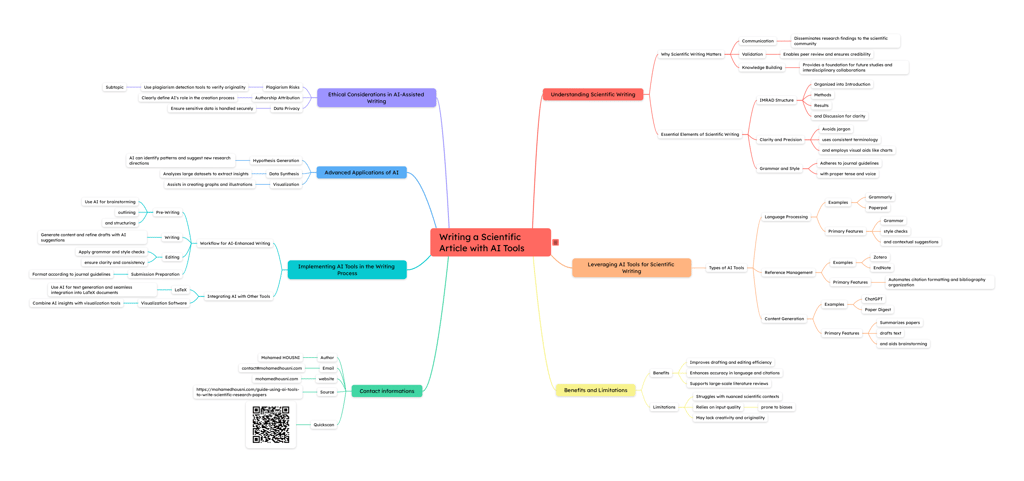Guide : Using AI tools to write scientific research papers
Harnessing Artificial Intelligence Tools for Effective Scientific Research Writing
Mohamed HOUSNI
1/2/20252 min read


Writing a Scientific Article with AI Tools
Scientific writing is a cornerstone of research, enabling the dissemination, validation, and advancement of knowledge. With the rise of artificial intelligence (AI), researchers now have access to tools that streamline the writing process, from drafting to submission. This guide delves into how to leverage AI tools effectively in crafting scientific articles.
Understanding Scientific Writing
Why Scientific Writing Matters
Communication
Scientific writing disseminates research findings to the broader scientific community, fostering collaboration and progress.Validation
Structured writing enables peer review, ensuring the credibility and reproducibility of research.Knowledge Building
Scientific articles serve as a foundation for future studies, contributing to interdisciplinary collaboration and innovation.
Essential Elements of Scientific Writing
IMRAD Structure
Articles typically follow the IMRAD format: Introduction, Methods, Results, and Discussion, ensuring clarity and logical flow.Clarity and Precision
Avoid unnecessary jargon, use consistent terminology, and enhance comprehension with visual aids like charts and graphs.Grammar and Style
Adhere to journal guidelines, maintain proper tense and voice, and ensure linguistic precision.
Leveraging AI Tools for Scientific Writing
Types of AI Tools and Their Features
Language Processing
Examples: Grammarly, Paperpal
Primary Features: Grammar checks, style improvements, contextual suggestions
Reference Management
Examples: Zotero, EndNote
Primary Features: Automates citation formatting and bibliography organization
Content Generation
Examples: ChatGPT, Paper Digest
Primary Features: Summarizes papers, drafts text, and aids brainstorming
Benefits and Limitations
Benefits
Efficiency: Speeds up drafting and editing.
Accuracy: Enhances language precision and citation accuracy.
Support for Literature Reviews: Quickly synthesizes information from vast datasets.
Limitations
Limited Contextual Understanding: May struggle with nuanced scientific concepts.
Dependence on Input Quality: Errors or biases in input data can lead to inaccuracies.
Creativity Constraints: AI tools often rely on existing patterns, lacking originality.
Ethical Considerations in AI-Assisted Writing
Plagiarism Risks
Use plagiarism detection tools to ensure originality and proper citation practices.Authorship Attribution
Clearly define AI's role in the creation process to avoid ethical disputes.Data Privacy
Protect sensitive research data during AI processing to maintain confidentiality.
Advanced Applications of AI in Research
Hypothesis Generation
AI can identify patterns in data and suggest novel research directions.Data Synthesis
Tools analyze large datasets to extract meaningful insights efficiently.Visualization
AI assists in creating graphs and illustrations that enhance data presentation.
Implementing AI Tools in the Writing Process
Workflow for AI-Enhanced Writing
Pre-Writing
Use AI for brainstorming, creating outlines, and structuring articles.Writing
Generate initial drafts and refine them with AI suggestions for better readability.Editing
Apply grammar and style checks, ensuring clarity, consistency, and adherence to journal guidelines.Submission Preparation
Format documents for submission, including figures, tables, and citations.
Integrating AI with Other Tools
LaTeX Integration
Use AI for text generation and seamless incorporation into LaTeX documents for professional formatting.Visualization Software
Combine AI insights with tools like Tableau or Python libraries to generate graphs and other visual representations.
By embracing AI tools, researchers can transform their writing process, focusing more on innovation and less on repetitive tasks. Whether drafting, editing, or preparing for submission, AI offers valuable assistance, making scientific writing more accessible and efficient.
Download Resources
To help you implement the strategies discussed in this guide, we’ve made several resources available for download:
Mindmap Summary of the AI Writing Process
A visual summary of how AI tools can streamline your scientific writing process.
Download the Mindmap for Free hereResearch Article Template
A customizable template following the IMRAD structure to help you organize your article effectively.
Download the Research Template for Free here
These resources are designed to support your writing process and help you get the most out of AI tools for your scientific articles.


